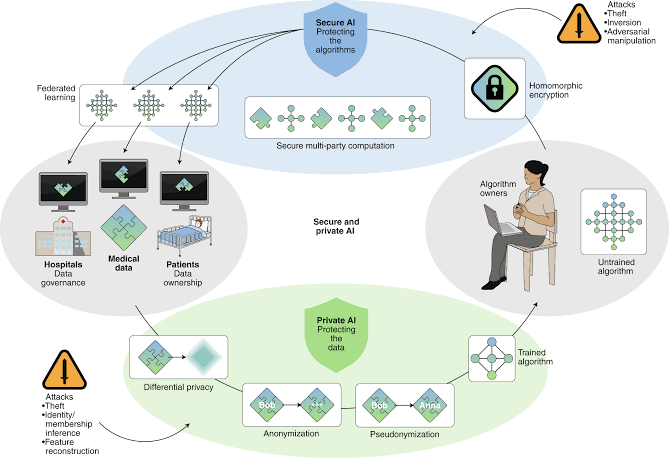Traditional ML requires centralizing data in one repository—raising privacy, security, and compliance concerns. Federated learning flips the script: models are trained locally on distributed devices or servers, and only weight updates (never raw data) are shared, enabling collaborative intelligence while keeping user data on‑device.
1. How Federated Learning Works
- Initialization: A global model is sent to each client node (e.g., smartphone, hospital server).
- Local Training: Each node updates the model using its private data for a few epochs.
- Secure Aggregation: Nodes send encrypted gradient updates to a central server.
- Model Averaging: The server aggregates updates (e.g., via FederatedAveraging) to refine the global model.
- Iteration: The improved global model is redistributed—cycle repeats until convergence.
2. Real‑World Applications
- Mobile Keyboard Prediction: Gboard uses federated learning to personalize text suggestions without uploading users’ keystrokes.
- Healthcare Consortiums: Multiple hospitals train joint diagnostic models (e.g., for tumor detection) without sharing patient records.
- IoT Anomaly Detection: Smart meters detect fraud patterns locally, contributing to a more robust global fraud‑detection model.
3. Privacy & Security Mechanisms
- Differential Privacy: Injects carefully calibrated noise into gradients to mathematically limit individual data leakage.
- Secure Multi‑Party Computation (SMPC): Ensures that server only sees encrypted aggregates, not individual contributions.
- Trusted Execution Environments (TEEs): Hardware‑based enclaves (e.g., Intel SGX) protect code and model parameters during aggregation.
4. Technical Challenges & Best Practices
- Data Heterogeneity: Clients’ data distributions often differ (non‑IID); use adaptive optimization (e.g., FedProx) to maintain fairness.
- Communication Overhead: Compress updates with quantization or sparsification to reduce bandwidth demands.
- Client Availability: Design for stragglers and drop‑outs—implement asynchronous updates and deadline‑based aggregation.
5. Getting Started: A Developer’s Roadmap
- Select Framework: TensorFlow Federated or PySyft for PyTorch are mature open‑source libraries.
- Prototype Locally: Simulate multiple clients on a single machine to validate aggregation logic.
- Secure Aggregation Setup: Integrate differential privacy APIs and configure SMPC protocols.
- Scale to Real Devices: Deploy to a fleet of edge devices or partner servers—monitor latency, convergence, and model accuracy.
6. Case Study: Collaborative Disease Prediction
- Scenario: Three clinics aim to improve diabetic retinopathy detection but cannot share patient images.
- Implementation: Each clinic runs local training on secure servers and contributes encrypted updates.
- Outcome: The federated model achieves 91% accuracy—on par with a centrally trained counterpart—while preserving full patient confidentiality.
Conclusion
Federated learning represents a paradigm shift for privacy‑sensitive ML: by keeping data local and sharing only model insights, it unlocks collaborative scale without compromising compliance. As frameworks mature and use cases proliferate—from mobile apps to healthcare consortiums—organizations can harness collective intelligence while upholding the highest privacy standards.









